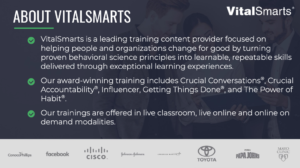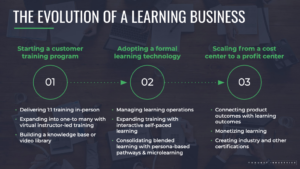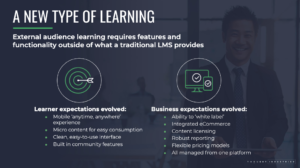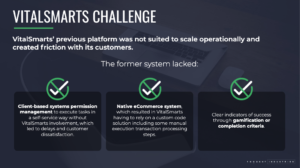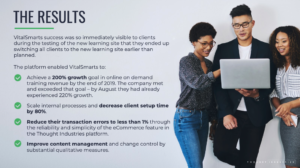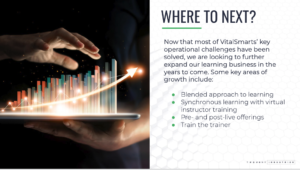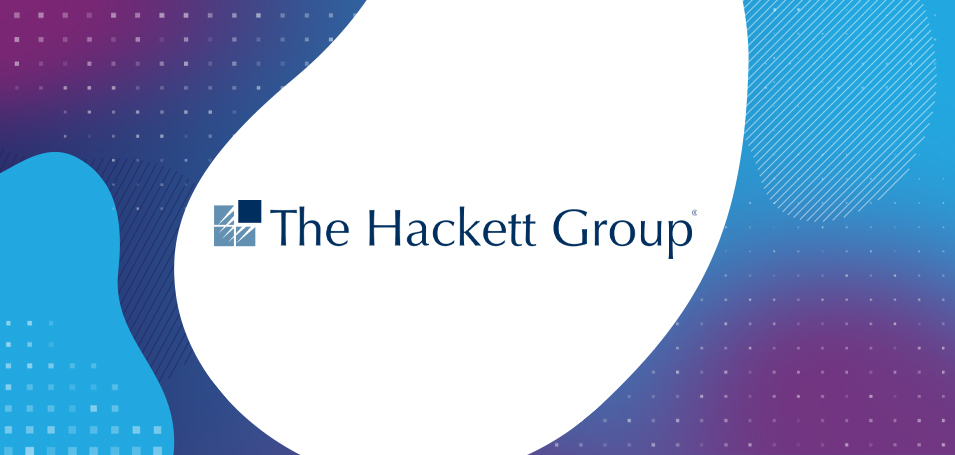Recently, Russ Rollins, Senior Director of Product Technology at VitalSmarts and Arthur Harrington, Enterprise Customer Success Manager at Thought Industries, got together for a lively discussion around VitalSmarts experience growing their corporate leadership training business, and the challenges they had in scaling the training and blended learning solutions that ultimately led to their 200% revenue growth.
Ensuring exceptional learning experiences
Russ Rollins (VitalSmarts):
VitalSmarts is a behavior change company. We’re rooted in teaching repeatable skills through proven behavioral science principles, delivered through our certified trainers. We’re focused on ensuring that the learning experiences in acquiring those skills are highly exceptional. We’re very proud of the premium nature of our delivery.
We started with a crucial conversations training program many years ago and have added more solutions to our offerings to help people and organizations change. We began in the classroom, but over the years we’ve adjusted, attuned, and refocused on the importance of the modern learner experience, selling training courses online and helping learners have rich experiences.
From cost center to profit center – selling online courses
Arthur Harrington:
As background, I would like to talk a little bit about the evolution of a learning business, from starting a customer training program all the way up to scaling from a cost center to a profit center and selling online courses.
Typically, at stage 1, you have a business with a product. The products are being sold and customers like the product. All of a sudden the organization realizes, “Hey, we need to train our customers.
Who’s going to train them? Susan knows our product really well. She’d be great.” Susan becomes the trainer and now Susan is going out on the road training folks or using WebEx to do some virtual instructor-led training. Along the way, she’s starting to build the rudiments of a knowledge base.
At some point, you realize you’ve got content that needs to be managed. You want to formalize your deliverables and make sure that you’re delivering consistent training. Perhaps you hire a training team, or a content team. Maybe you bring in a manager of training who starts to put some processes around what’s going on. At this point, you may decide to create an online course to expand your training with some interactive self-paced learning.
Now it’s time to start shopping around for a learning management system (LMS) that’s going to organize this and deliver self-paced training. And perhaps, you also expand training into blended training, and start to build out training pathways, and micro-learning. You’re beginning to grow your business and cost the organization money, and they want to know what’s the payback. What’s the ROI on all this training?
You get the ROI from customers using your products effectively. Folks really need to be trained. It’s really important to tie the product outcomes to the learning outcomes. Another option is monetizing the learning. What is this training worth? There’s always a discussion around whether you should charge for training. My personal belief is that people value what they pay for, and that’s proven out in research. You can also begin to build out certification programs.
Those are some of the things that you may find when you’re scaling up to becoming a profit center, rather than just a cost center. And remember to also look at cost savings, like the impact on support. If you are effectively training folks and providing them with documentation, then you should reducing support tickets.
The challenges of scaling an online learning business
Arthur Harrington:
We’ve discovered that traditional learning management systems are really designed for internal training. Also, they often require complicated third-party integrations. If you want to integrate Salesforce for improved learning operations, for example, or ecommerce. Typically that’s an extra cost.
Often, there’s an outdated user experience for administration. The user experience could also be something that’s clunky. “Hey, go to this webpage, click here, login with this, and if everything works right, you should be able to see your training content.”
There may also be barriers to efficient content management. At this point you may have one team managing the LMS, and another team managing content. This team may be building content in another platform, and then passing it over to the LMS team. This isn’t efficient. It’s another challenge of scaling.
As a profit center you want to show that the training department is profitable. But many traditional LMS systems were not built for monetization. Tracking sales on Excel spreadsheets is not the ideal way.
Arthur Harrington:
Years ago, customer training involved getting a bunch of people into a room. The trainer spouts their expertise for a day, or two, or three, and hopefully folks absorb it. That model is outdated now, both from the learner expectation side, as well as the business expectations.
Learners expect on-demand content, mobile, anytime and anywhere. Perhaps they’re at work or on the road and they need to know how to do something quickly – just pull out your phone. It’s also micro content, which means chunking training into small bits so that it’s easily consumed and easily digestible.
Just think of the YouTube experience. People are looking for quick, easy answers. They also want a clean, easy-to-use interface. Think of Google, there’s one box, you type it in, and there’s your answer.
Learners want to login to a dynamic learning platform that changes based on what they’re doing. Perhaps it has a dashboard that shows what they’ve completed, where they are in the journey. Maybe it recommends training.
Perhaps there’s a community. Imagine if you go through a course, and you see there’s other people in the course. You pose a question, and they respond to your question. It’s like having a cohort of folks going through a class together where you build a relationship. Russ, does this mirror what you’ve seen?
Russ Rollins:
Our journey to where we are today included several different pain points. And some of these were very apparent like, “Oh for sure, we need to have mobile learning.” But other things, not so much.
In figuring out why we were experiencing friction with our customers and our operations team, it really came down to the role of the trainer inside the organization. We’ve invested in this individual and they are now a subject matter expert, a coach and a mentor. As we moved into the modern, blended customer training environment, to be truly effective this trainer needs to see what the learners are doing. The solution we came up with satisfied the customers, the trainers, operations, as well as our data requirements for privacy and security.
We gave the trainers, the SMEs, the information they needed through custom permission management so that the trainer can interact with the data in a way that is building a bridge of mutual benefit for both VitalSmarts and the learner.
Our buyers aren’t always the business decision makers. Sometimes, we work with organizations that have a strong need to solve a cultural challenge or a business problem, but they don’t have the budget capability for traditional L&D development and deployment.
Integrated ecommerce with a customer training platform
To address their financial constraints, we needed an ecommerce system that would be flexible, easy-to-use, and built-in to avoid gluing together systems. Having a native ecommerce training solution really opened up opportunities to expand the training, and solve business problems for different organizations in a way that they couldn’t before with their budget constraints. Now, once those learners get in, then they want to know, what does it mean to start, and what does it mean to end?
If you go to our public workshop, you know you’re there for a couple of days because that’s the training duration. But when you do something online, progress is at a different rate. People watch videos, and think about them at a different rate. Learners need to know how far along they are.
We thought we could award badges, and that would be enough to signify course completion. But it turns out that’s not the case. Learners that are using training for professional development need to know where they’re at along that training journey. Otherwise, they get frustrated.
Key features of a customer training platform for professional training
Russ Rollins:
Let’s talk B2B for a minute – what does it mean to manage licenses?
A training content company like VitalSmarts must accommodate the business needs of our buyers and learners. What we don’t want is 12 different spreadsheets that are managed by month or managed by contract, because that is a nightmare. Scaling the profit center is not achievable without adding more and more people.
It had to be automated. We needed a customer training system to cover that gap so that our ops team felt enabled, and the process could be implemented inside the system instead of outside of it.
Single sign-on (SSO) is really critical when you’re talking to organizations that are super particular around their security setup or their data management. You do not want to jeopardize the relationship because you can’t do single sign-on. It’s needless friction.
We needed a system where it’s no problem. We want to make sure that when we build our products, and we then provision those products to our buyers, that we don’t have 25 different clones of the same product. What we do want is to offer a white labeling capability. The core training content remains intact. We can just change our master source of that training content, and it propagates throughout. It is critical that we are able to accommodate that type of approach. That really helps scale out training, development and delivery.
Our clients want to understand what the engagement of their customers is, their learners and where are they stuck, or where are they having questions. So, it was important for us to be able to demonstrate that our online solution includes your ability to jump into your dashboard. No need to email VitalSmarts to schedule a report. It’s all there. You can go in and do what you need inside the system.
Arthur Harrington:
Help them help themselves.
Russ Rollins:
We found we also needed a customer training platform that can accommodate different languages for our learners in different countries. “In the moment learning” is quite unique for us. The concept applies to anything that might be in an instant where people’s minds are enlightened, or their heart opens, and they’re suddenly going, “Wait, I’ve learned something here.”
It’s a collaborative moment. For instance, in a crucial conversations course, I witness a business interaction inside a video that demonstrates bad behavior. And somebody is going to get really frustrated, and emotion is going to skyrocket, and there’s going to be a challenging moment.
Our intent is to make these super realistic, and demonstrate what’s happening in different industries, in different environments so that the learners can have a sense of resonance. With the new customer training LMS, we can create dialogue and interaction around that video.
Learners are seeing real-time comments from their learning partners, and they can interact. It prompts the learning moment, to connect what they’ve seen with the new skills they have. This has been really important for us, and for our learners.
The importance badges AND visual learner progression
Arthur Harrington:
Here we have a couple of slides that show some of the functionality you’re talking about.
Russ Rollins:
As we said earlier, our learners told us they needed something more than just badges to demonstrate training progression. The screen on this chart is from our crucial conversations online course, on the Thought Industries customer training platform. As you can see on the left-hand side, progress towards completion is very visible and very evident.
We don’t prescribe a linear format for our learners, and yet we want to be able to show what needs to be done to finish. There’s a “content-viewed” section underneath the total progress meter and there’s a “past assessments” area, which shows exactly what needs to be completed. So, it’s a very easy way to see exactly what I have to do to finish.
eCommerce functionality in customer training platforms
Russ Rollins:
The ecommerce component of our new customer training LMS makes it so much easier for our learners to understand and to buy. It’s also easier for our organization. And by that, I mean anytime you introduce transactions with money exchanged, you’re going to have an operations team, or a finance team, or somebody that will be a stickler for detail.
Our experience has been the more things that you add in, that you require of the ecommerce component, the more challenging your outcome is going to be to satisfy both your learner/buyer and your internal teams. With this new platform, we have the ability to manage the internal requirements, and present an easy enroll-now checkout experience – all inside the online training system.
Making it easy to get from “I’m interested in this, I get the value of it, and I want to proceed,” is very important.
License and data partitioning for customer training
Russ Rollins:
Let’s say we’ve got a contract in place, and we’re going to sell a set of licenses. It’s important for the ops team to be able to do everything they need within the system.
Our new customer training platform from Thought Industries has put us in a very good place. We are able to leverage the platform’s capabilities to manage licenses, and scale without having to hire more people. With this LMS, we achieve all the data partitioning we need, all of the security we need, and accommodate the white label components.
Arthur Harrington:
Once again, trying to make it easy on yourselves as well as the client.
Russ Rollins:
Exactly. Reduce friction.
Arthur Harrington:
You want to talk a little bit, Russ, about the results VitalSmarts has achieved so far?
Russ Rollins:
Great results this year, with the help from the Thought Industries team. We had a pretty strong target for 200% growth in our online, on-demand licenses, and we surpassed that in August. We attribute a lot of that to the partnership, and to the capabilities of the Thought Industries customer training platform.
Once our ops team had a sense of confidence in the new platform, and the quality of the product is enhanced, sales begins to feel more comfortable, more confident, and more convinced. We are also seeing a huge reduction, up to 80%, in client learner setup time.
I mentioned how important it is to be able to make ecommerce simple in your LMS. The result of the new LMS is that the transaction error rate is now below 1%. That’s almost nothing based on our previous experience.
Training content management for multiple clients
And lastly, we have seen major improvements in LMS content management largely because of our new ability to go into those master courses, make necessary changes, and know that all we have to do then is hit the publish button. We don’t have to go into each of the clients, and make changes there. It just goes, and boy that’s a breeze.
Arthur Harrington:
So, Russ, where to next? Is the number going up to 400% next year?
Russ Rollins:
We sure hope so.
Arthur Harrington:
I’d like to add one last thought.
We think the road to success, to increasing engagement and reducing customer churn, is to find an LMS provider that is willing to work in partnership with you, to understand the complexity of your business, how you’re looking to grow, how you need to scale. It’s not just what the technology can do, but the support you get over the long term.

